The Roman Empire lies in the cradle of one of the biggest civilizations in human history. We tried to explain the Roman Empire in 31 maps, its rise and fall, its military superiority, its impressive infrastructure, economy, and many more maps.
Watch the Roman Empire rise and fall in this video
The video below shows how fast the republic and empire expanded and declined over a time period of 1229 years.
When did the Roman Empire start & how did Rome take over Italy?
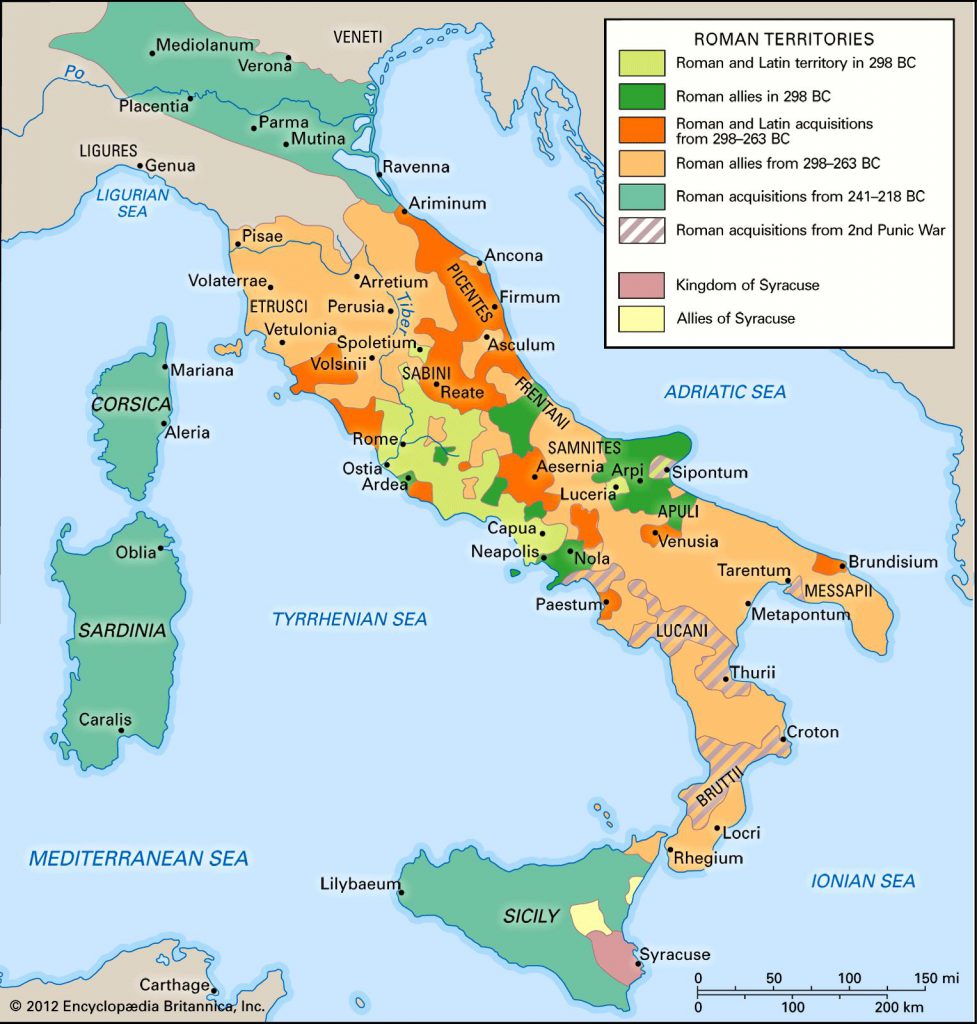
Rome was a small city-state in the early 7th Century BC near the Tiber River and was somewhat of a confederation of smaller towns and Villages. Traditionally believed to be established on the 21st of April, 753 BC by Romulus, with time the population grew and so did the commerce and agriculture and thus the City of Rome.
It then began to accrue regional power, in terms of politically, economically and militarily and expanded to include the entire Italian Peninsula by the 3rd century BC, overwhelming the other populations such as Etruscans, Sabines, and Samnites who shared the Peninsula with the Romans (Who are of Latin Origin). When did the Roman Empire start? Why was the Roman Empire successful?
Did you know?
According to the Legends, Romulus and Remus, twin brothers was nursed and taken care of by a She-wolf!
The extent of the Roman Republic from 218BC to AD117
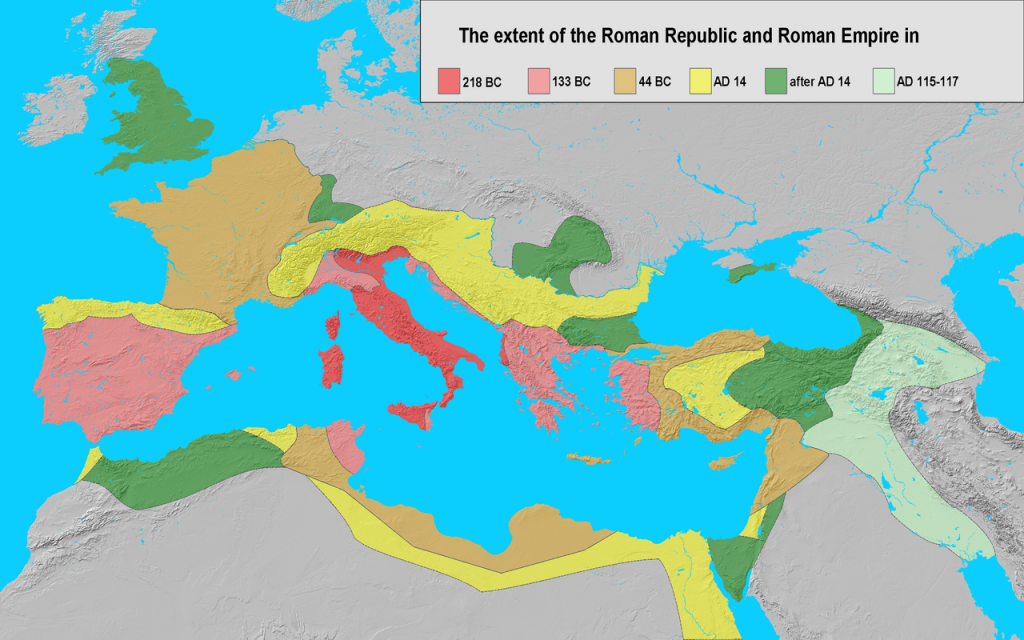
Why was the Roman Empire successful?
Roman Empire government
As the Republic system of Governance came to an end during the 1st century BC under conspiracies, military and social upheavals and deep political divisions among the ruling class, a new order emerged.
Julius Caesar, then one of the most powerful people in Rome challenged the Senate’s right to Rule and along with 2 other successful political statesmen, namely, Pompey and Marcus Lysinius Crassus formed the 1st Triumvirate, the all-mighty council that was held supreme and the final authority.
After the assassination of Julius Caesar and Augustus Caesar ascending to the throne as the “Imperator” or the Emperor, a nominal and symbolic Senate continued. The controlling power of both Economy and Military was handed over to the Emperor and consequently, the empire was transformed into an Authoritative-Monarchy through Centralization of Power to the Emperor. However, the senate nominally legitimated the Emperor’s rule.
The new imperial government structure was hierarchical and consisted of four components.
- The Emperor
- The Military
- Provincial Governments or Provinces
- Roman judiciary system
The military was to annex new land and kingdoms on behalf of the Roman Empire (by militarily or diplomatically) and police them after a successful annexation.
An annexed territory was then transformed into a Province of the Empire with a Governor appointed by the Emperor who acted as the central figure of power for that province.
Did you know?
At its height during the 1st century AD, Rome was the largest city in the world and empire’s population was one third of the Global population!
The Roman courts held the ultimate jurisdiction over any person or property in the Empire. But as the empire was vast and stretched from Britannia (today UK) to Mesopotamia (Today Iraq), Rome adapted a policy “Mos Regionis”, Respecting the traditional laws of the occupied lands, and thus enforced the traditional laws of the annexed territories trough government-appointed officials and used local laws as a source of “Legal precedent” and “Regional stability”.
The Roman Army
What was life like in the Roman army? The Roman army consisted of Professional Soldiers with a volunteered period of 20 years in the active military service and 5 more years in the Reserved forces. In Rome, it was a full-time career and acted for the elite class members as a pathway for a glorious political career as well.
The primary mission of the Roman military was to Preserve the “Pax Romana”, the period of a continued era of peace from Augustus Caesar’s reign from 27 BC to until the 284 AD. In addition to this, maintenance and the protection of Roman Citizens and policing the annexed territories were also among the main objectives.
The three major divisions of the Roman Military were,
- The Garrison at Rome, which includes both the “Praetorians” the emperor’s personal protection force and the Vigiles, who functioned as the police, firefighters and protectors
- The Provincial army, comprising the Roman legions and the Auxiliaries provided by the Provinces (auxilia)
- The navy.
Roman military formation
The Roman military structure comprised of Legions, each encompassed 5000-6000 legionaries or Soldiers. A Legion was organized by adjoining 10 “Cohorts”, which had approximately 480-500 soldiers. A Cohort was organized into 06 Centurions, in which each contained 80-100 men and a Centurion was further separated into 10 squads for the ease of logistical and transportation requirements. The Exact number of How many men were in a Roman legion is still a bit debatable as the size legions had changed slightly over geographical differences.
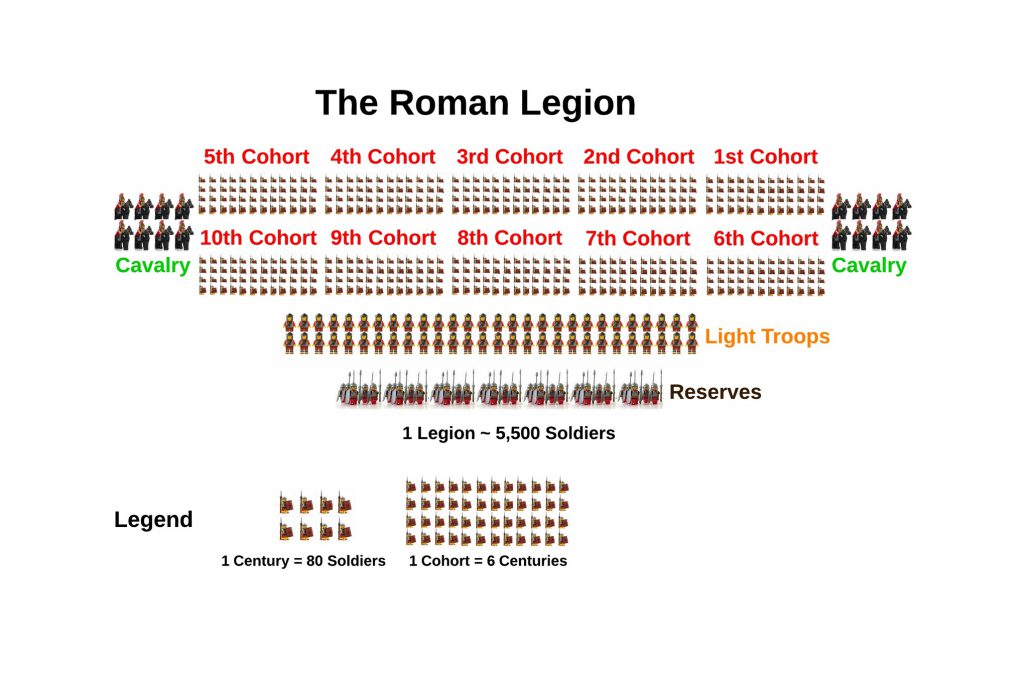
In addition to Infantry, the imperial army also had a Cavalry force as well. But Roman Cavalry was generally weak in cavalry warfare and relied heavily upon Auxiliary Cavalry support from regional tribes.
During Battles, the Fighting Army arranged into many different formations according to the,
- Size of the Army and the Enemy army
- Geographical and Weather Conditions and
- Fire-power and siege tactics available
Rome utilized various “Battle Formations” during the wars they fought such as,
- Wedge Formation: A Linear formation with many soldiers pointed and concentrated at the center (like a Wedge/Spear-tip) to smash through weak enemy lines.
- Extended Line: Legions deployed in a line to over-lap enemy lines and secure the flanks.
- Rolling up the Line: Concentrating man-power on either left or right side of the battle line to overwhelm enemies from one side and then “roll-up” and attack the enemy from the rear.
- Weak Centre formation: the center of the battle line is intentionally left weak and both left and right flanks strengthened with more soldiers. As the enemy attack the center, the much stronger flanks would attack the enemy from the side and surround them.
What was the Roman military size?
During the 1st century AD, the Roman army was around 100,000 men strong and by the end of the 3rd Century. Approximately it was just under 400,000 men.
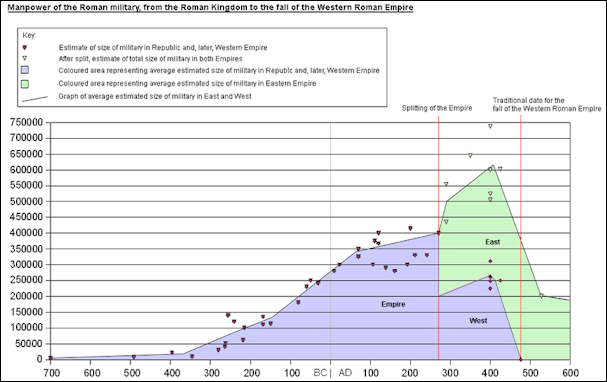
At the height of its power, the Roman Military was approximately 500,000 soldiers strong, in addition to all the Triremes, transportation ships, and Siege weapons.
Adoption of the best beliefs, customs, and achievements
Romans were a flexible civilization and always adapted and absorbed the better beliefs, cultural elements, languages, economic practices, military practices and technological achievements of other civilizations, often from the conquered nations.
Did you know?
The Wealthy and Aristocratic Romans used speak Greek!
Did you know that wealthy and aristocratic Romans spoke Greek rather than Latin?
This socio-cultural, economic and technological adaptation would become the major influencing factor behind Rome’s continuous endurance for more than a Millenia in the ancient to Medieval geopolitical arena as a superpower.
Map of theaters, libraries, baths in the Roman Empire
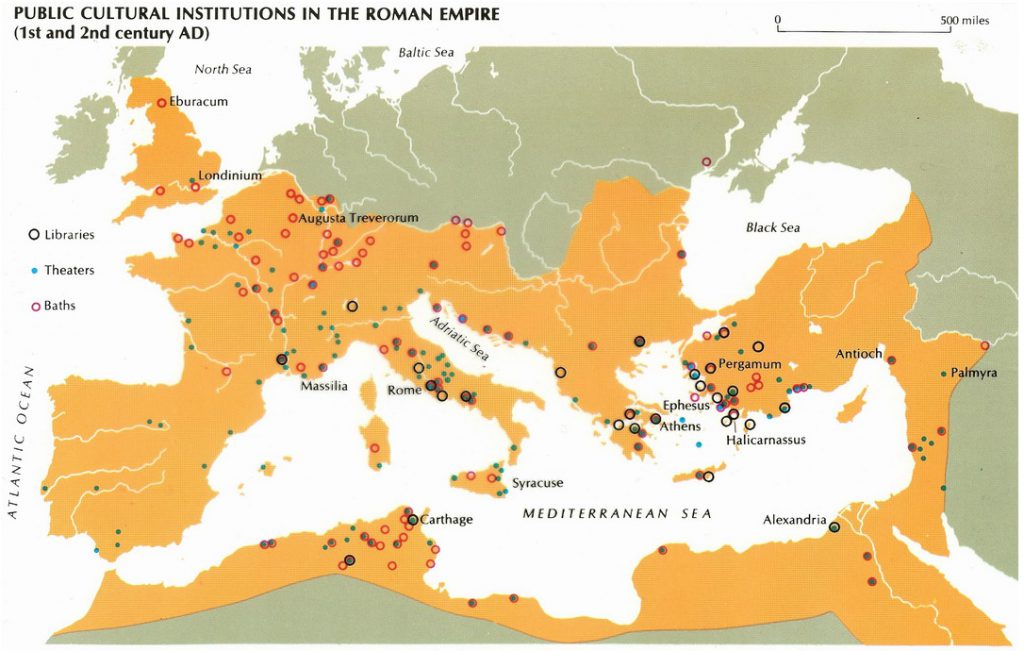
Trade in the Roman Empire
The Roman Economy was a Highly-Monetized economy and the monetary aspects propelled the commerce and trade within the empire to greater and beneficial extents. Also, well-established trade routes and safe and efficient road systems contributed to this economic boom of the empire as well.
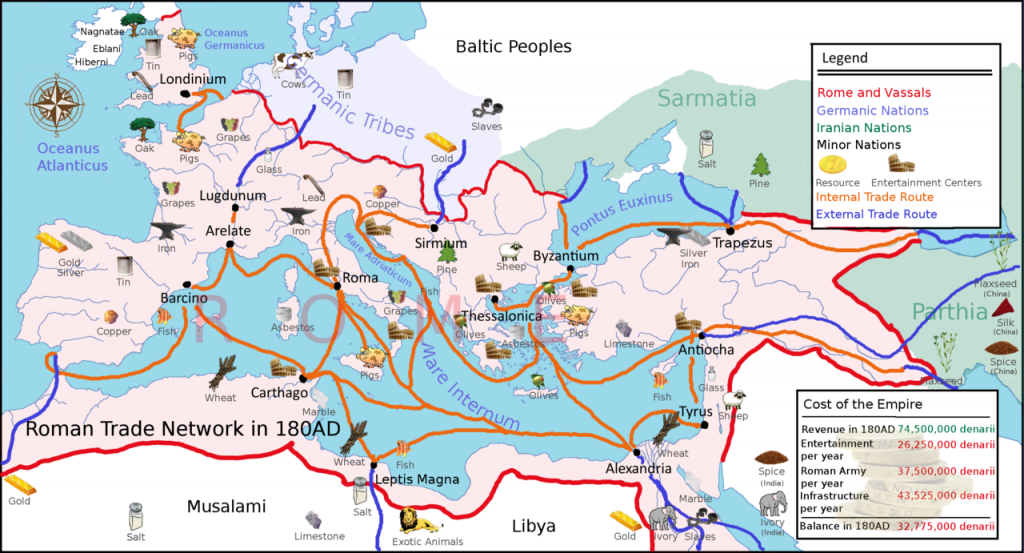
It was more of a Network of Regional Economies which was monitored and regulated by the central government and some scholars consider this as an early form of “Political Capitalism”.
The Currency system and the Primary Banking system was one of the most efficient and effective systems of that time, though Rome lacked a specific system for banking. It enabled merchants from far corners of the empire to trade and engage in business in a common currency and with relative safety.
Slaves were a major part of the economy as well. Slave labor was used in many labor-intensive industries
Did you know?
Spartacus, a slave gladiator led a revolt against the Rome during 73 BC-71 BC. Almost 40,000 slaves joined his revolt and it was one of the worst home-grown threats in Roman History!
The Agricultural sector was very productive as well as the empire and the lands it occupied grew rapidly during the imperial era, enabling large-scale reorganization of lands for surplus production and specialization.
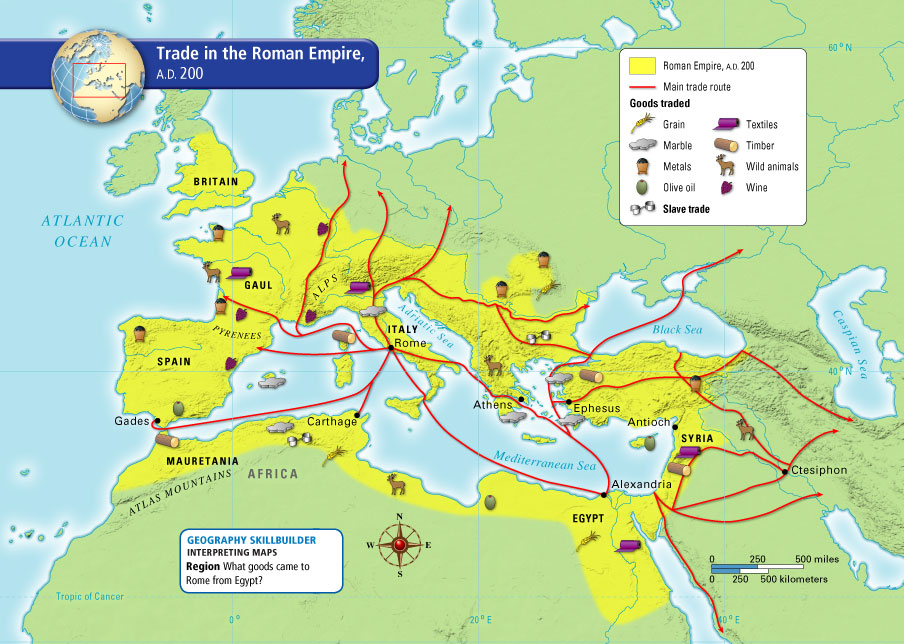
In addition, the construction industry, gold and silver industries, and mining industries were also well-developed and sophisticated.
Per capita income in the provinces of the Roman Empire in 14AD
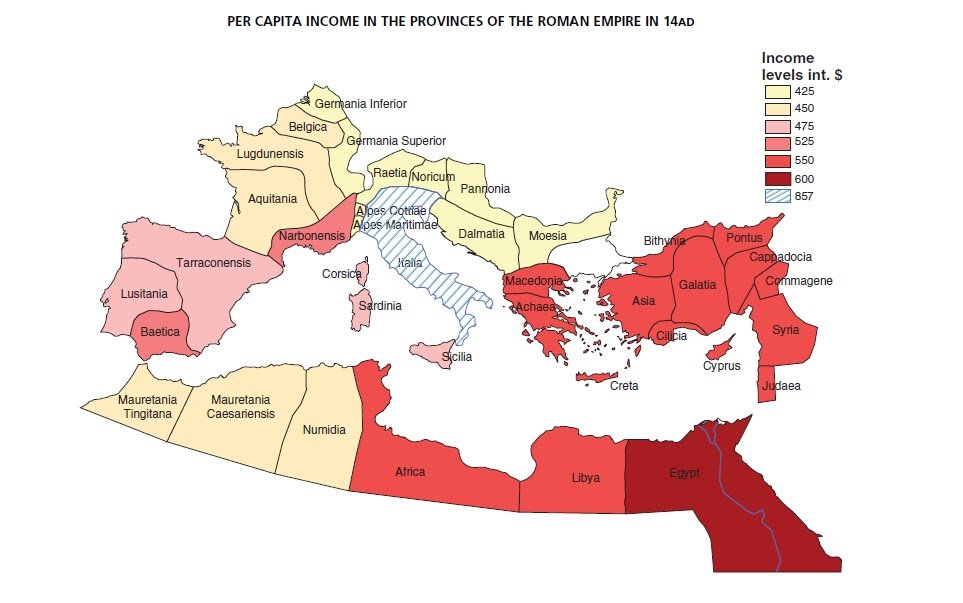
Roman Empire road map
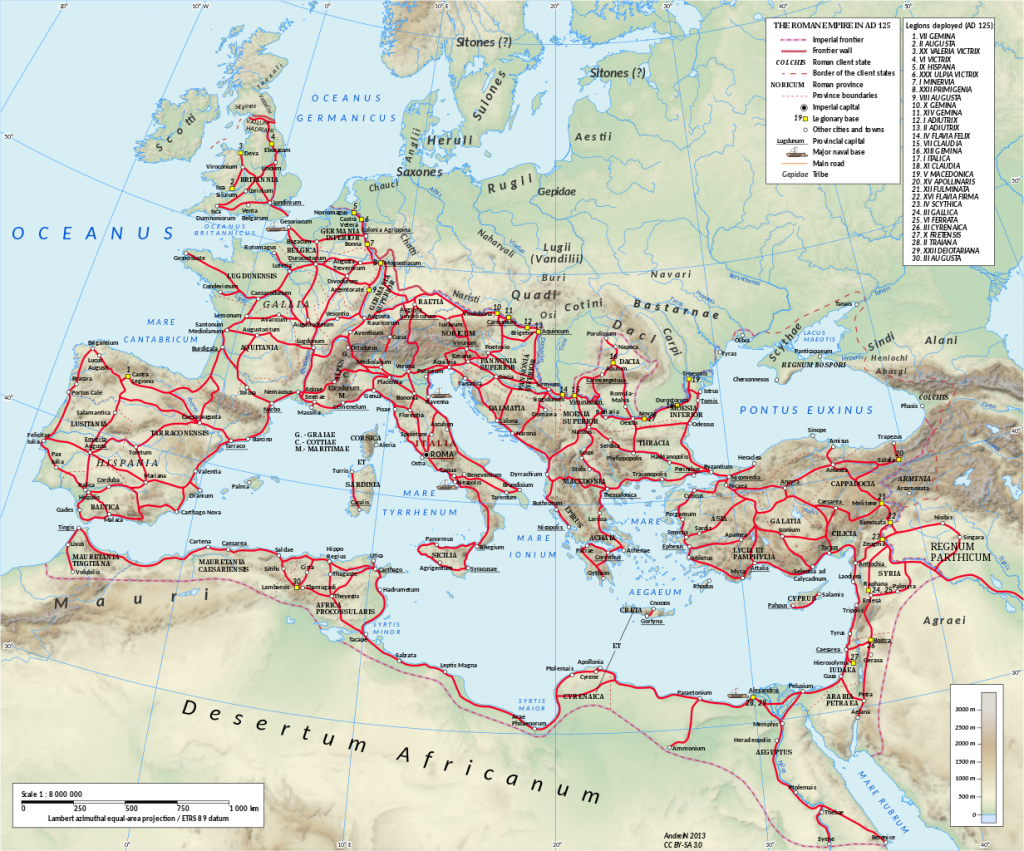
As the Empire expanded into much remote and farther areas, the need for safe, fast and effective transportation grew as the Armies of Rome constantly required supplied during their military campaigns in the foreign lands. As a result, they constructed a quality and enduring road system that connected the empire.
“All Roads Lead to Rome”
Roman stateman Cicero
Roads were constructed mainly by using Concrete and what was primarily developed to make military logistics and supplies easier indirectly helped merchants, traders, constructors, bankers and ordinary Citizens in their ordinary economic endeavors.
Map of the Roman Empire at its height
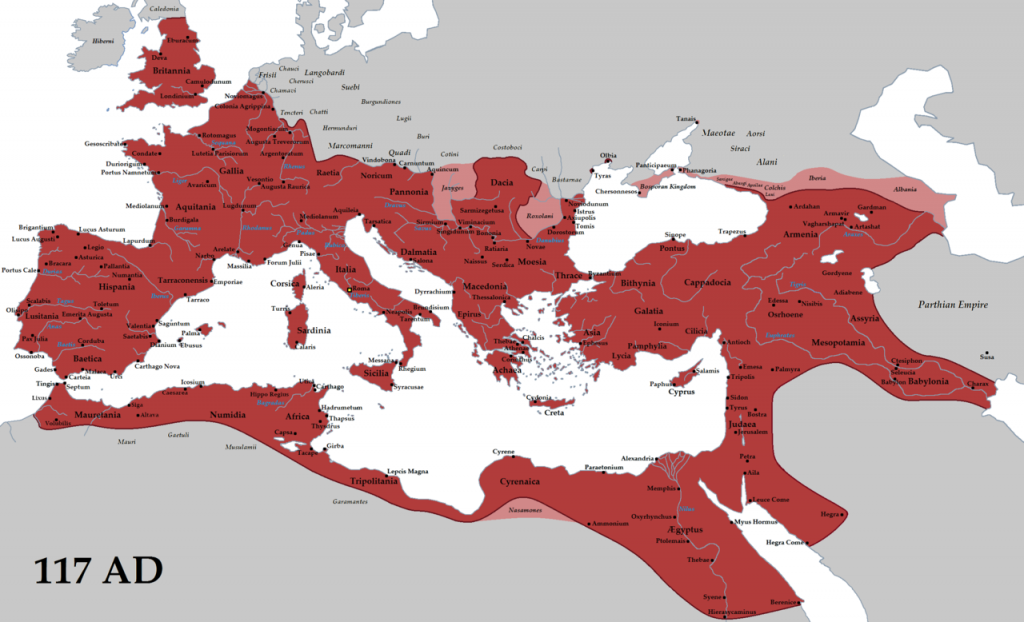
Under emperor Trajan, Roman Empire stretched to its extent from Britannia (Modern England) and Iberian Peninsula (Modern Spain and Portugal) covering a large portion of North Africa including Ptolemaic Egypt to Mesopotamia (Modern Iraq and Syria). It also included Anatolia (Modern Turkey) and much of Central Europe
Did you know?
According to some sources and Legends, Trajan has never lost a battle!
The Entire Mediterranean Sea was under the Roman Navy’s Command and Rome would stay the uncontested sea power of the region for nearly 500 years.
Map of Roman provinces
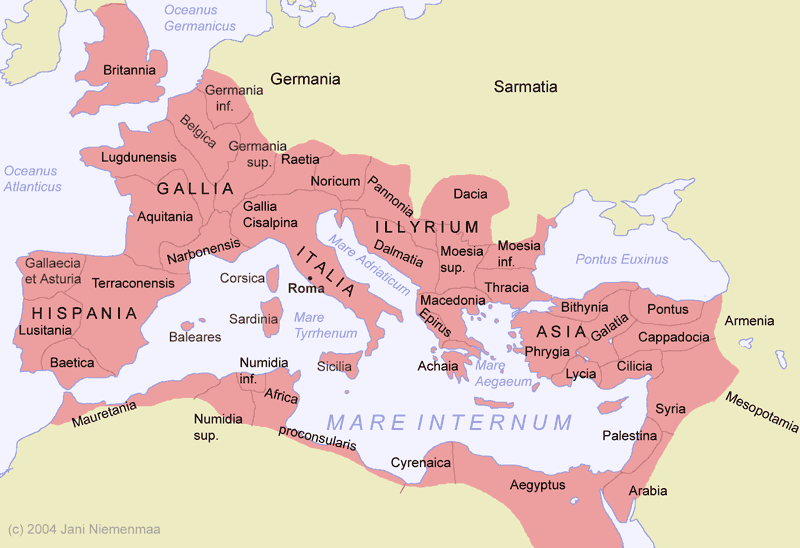
Emperor Trajan completed the most recent conquests
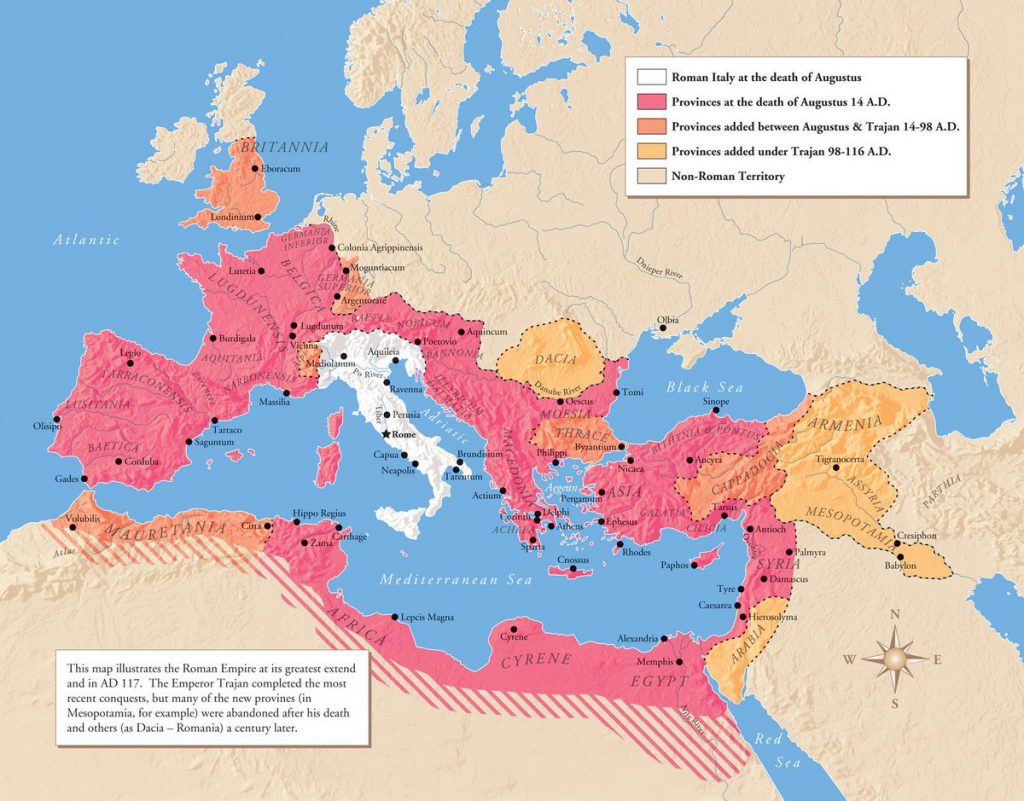
Very detailed map of the Roman Empire in 211AD
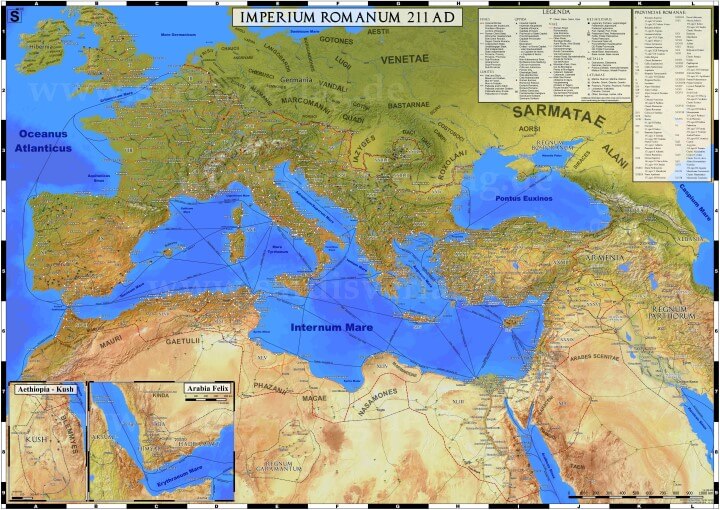
Roman Empire compared to the USA
At its height, how big was the Roman Empire? It controlled a land mass of almost 5.4 Million square kilometers and the entire Mediterranean Sea. The USA is larger in this respect, covering nearly 9 million square kilometers, yet Rome’s accomplishment as one of the longest lasted and largest empires in history is amazing.

Did you know?
Rome was the uncontested Super power in the World for nearly 500 years!
The US Constitution and the Political and administration mode is much inspired by the systems of the Roman Empire. Especially, the concept of Republic and power divisions between the senate and the emperor and other power checks and balances systems are also influenced very much by the Roman political and administrative systems.
The Roman walls to defend southern Britain from the unconquered north
Hadrian’s Wall
Emperor Hadrian constructed this wall as a part of his mission to fortify the Roman province of Britannia. It is the largest and the longest structure Romans build in their time and stretched 117 kilometers across northern England.
Antoine’s Wall
Antoine’s wall was constructed to replace Hadrian’s wall and extend the Roman territory further into the unoccupied lands in Britannia, approximately 160 kilometers into the territory. The wall stretched 63 kilometers.
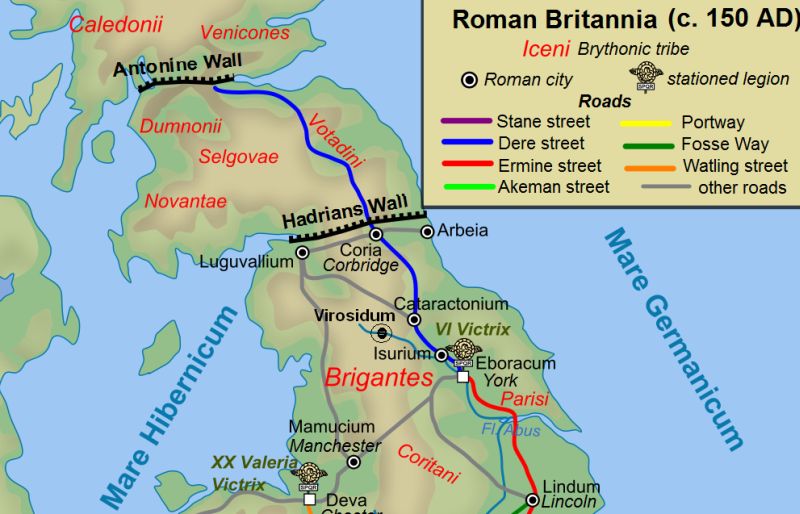
Top 5 greatest Roman generals
1. Nero Claudius Drusus (38-9 BCE)
If there is one man who had the courage to face the Germanics Tribes in central Europe, it was Nero. He is the stepson of Emperor Augustus Caesar and an accomplished general. His military strategies and tactfulness proved highly effective both in Land and Naval Battles.
Nero is the first general to launch a successful Roman military campaign across the Rhine river and began the conquest of Germania (Modern Germany, Austria, Poland). By 11 BC, he had subjugated many war-mongering, warrior tribes in the region, namely Sicambri, Chauci, Batavi, Frisii, and Marcomanni. In 11 BC, he led a successful naval expedition along the North Sea Coast against Batavi and the Frissii.
Nero was a strategic administer as well. After and before launching his major military campaigns, he fortified the Roman-Germanic border by the Rhine River by constructing a string of military bases and came into strategic alliances with some of the Germanic tribes to “soften up” the invasion.
However, during one of his expeditions, he fell from his horse and got badly injured. He held on for a month but ultimately was unable to be healed. Unfortunately, in the summer of 9 BC, Rome was deprived of one of her finest Generals.
2. Gnaeus Julius Agricola (40-93 CE)
Agricola was a Roman politician and a brilliant military commander who is responsible for Rome’s successful conquest of Britannia (Modern England and Scotland).
When he was appointed the Governor of Britannia, he arrived at a region in which even the Roman legionaries were scared-stiff of the heavy resistance put forth by the Britons. At that time the Britannic tribe Ordovices had virtually destroyed Roman Cavalry bases stationed in the region. Agricola was quick to move against them and defeated them in battle and then continued his victorious momentum into Caledonia (modern Scotland). Caledonians resisted fiercely with great numbers yet Agricola kept pushing forth, driving Caledonians further into their own territory. In the summer of 83 AD, Agricola faced Caledonians in open battle at the battle of Mons Graupius. Caledonians were led by the warrior-chieftain Calgacus and according to historians, the Caledonian army numbered more than 30,000. Although Romans were outnumbered nearly two to one, the Roman legions were more disciplined and their armor and weapons were much superior. In addition, Agricola’s army formation strategy was impeccable and he was successfully able to drive off the Caledonian invasion and put them on the retreat. Battle Casualties of this even is recorded as 10,000 on the Caledonian side and just 360 on the Roman side.
In 85 AD, Agricola was recalled from his governor post in Britannia and after that, he retired from administration and military services completely. In 93 AD Agricola died in his family estate in Gallia Narbonessis, at the age of fifty-three, leaving a glorious legacy as one of the greatest generals in the history of Rome.
3. Gaius Julius Caesar (100-44 BCE)
Julius Caesar was a man of intrigue and many talents. He was one of Rome’s most successful Generals, a strategic commander, a noble statesman and eventually would become the life-long dictator of Rome.
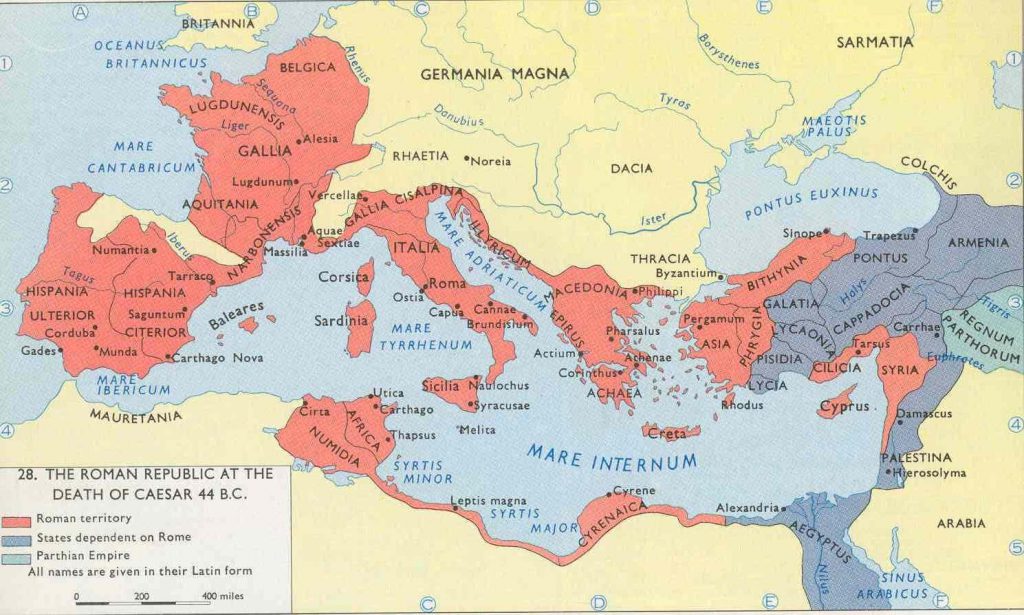
Julius Caesar came to prominence with his enormous success in the European Military campaign and especially as the subjugator of the tribes in Gaul. Before his victories, many believed these tribes like Arveni, Veneti and Germanic tribes were undefeatable. Julius Caesar made a fortune out of the war spoils and as the governor of these regions.
“I came, I saw, I conquered!”
Julius Caesar
The wealth he accumulated and the loyalty of his legions were enough for him to challenge the power of the senate and later with his immense influence in politics, formed the 1st Triumvirate alongside Pompey and Crassus, effectively becoming the “unofficial” ruler of the Rome
“I’d rather be the First in a Village than to be Second in Rome”
Julius Caesar
In 50 BC, the political divisions and strife among senate and the triumvirate exploded and the Senate, alongside Pompey, Caesar’s one-time ally, accused Caesar of treason and declared war on him. As Caesar came to Italy with his legionaries, a Civil War was ignited. Eventually, Caesar emerged victoriously and defeated Pompey and his forces at the Battle of Pharsalus, Greece.
Julius Caesar made many Economic and Governance reforms to consolidated Rome’s power and laid the foundation to make Rome the superpower it would become after his death. In 44 BC, a month prior to his assassination, Caesar was appointed the Dictator in perpetuity.
However, Caser’s growing power within Rome and his Rising popularity among people disturbed the senate, and consequently, the conspired to kill Caesar. And on the 15th of March when Julius Caesar attended the senate session, 60 senators stabbed him 23 times and assassinated him in cold blood.
However, his death would spark another Civil war which would give birth to the Empire of Rome and Julius Caesar remained a figure of central influence in politics, even today.
4. Marcus Antonius (83-30 BCE)
Marcus Antonius, commonly known as Mark Antony was a Roman politician and a general, and the Second in command of the Julies Caesar during his military campaign in Gaul.
Mark Antony was Caesar’s most trusted general and his life-long friend who was always at Julius Caesar’s side during his most difficult times, in both war and politics. Especially during wars such as the Battle of Alesia and the Civil war. When Pompey and the senate revolted against Julius Caesar’s rule, it was Mark Antony that he appointed as the administrator of Rome before pursuing Pompey and the senate loyalists to Greece.
After the Assassination of Julius Caesar, Antony would support Octavian, Caesars’s adopted son and heir, to eliminate the conspirators and became a part of the 2nd Triumvirate, alongside Octavian and Marcus Aemilius Lepidus.
After the defeat of the Caesar’s assassins, the so-called Liberators, Mark Antony was given the control of the Eastern Part of the Empire and eventually, sparks of hostility generated and a propaganda war escalated in Rome between Octavian and Antony which resulted in another Civil war which weakened Antony’s hold on Gaul and in Rome.
Did you know?
Mark Antony and Cleopatra were Lovers and had 3 Children.
Antony, aided by Egypt’s Cleopatra, considered disposing Octavian and making himself the ruler of the Roman world. But after the humiliating and unexpected defeat at the Battle of Actium, and Antony was forced to flee.
In August, 30 BC, as Antony had no way to fight back or resist, he decided to take his own life in the mistaken belief that Cleopatra had committed suicide as well, and stabbed himself with his sword. However, before dying he found out that Cleopatra was alive and some of his friends brought Antony to Cleopatra, his lover, before his death. Soon after, Mark Antony died in the hands of Cleopatra.
5. Marcus Vipsanius Agrippa (63-12 BCE)
Agrippa was a Roman Consul, a statesman, a successful general, a son-in-low of Julius Caesar and an Architect. He was the Right-hand man and the most trusted, best friend of Octavian, who later became the 1st emperor of Rome as Augustus Caesar.
His chief military achievement was the victory he ensured for Octavian’s forces at the Naval battle of Actium, where the combined fleet of Mark Antony and Cleopatra was defeated. Agrippa was one of the main reasons for Octavian to become the emperor and as an accomplished architect, he supported Octavian to turn Rome from a “City of Bricks to a City of Marble”. During his time as the chief administrator of the city of Rome, he constructed and renovated many buildings and constructions which benefited both the elite class and the middle class of the city.
Baths, aqueducts, porticoes and even magnificent gardens were designed and commissioned to be constructed by Agrippa. Leaving a Legacy of a great military leader and an artistic architect alike.
3 of Romans decisive battles
Rome proved to be the home for many elite strategists in the antiquity. Among the accomplishments of the Rome, the major victories are the Roman Conquest of Greece, the Roman Conquest of Britain and the Conquest of Gaul.
First Punic War (264 to 241 BC) – seize of Sardinia and Corsica
“Punic wars” is the term coined for the Battles fought between the Roman Republic and the North African Super-state of Carthage. There were three Punic Wars. And the First of them were fought mainly for the control of the isle of Sicily, which had an immense potential for agriculture and both Carthage and Rome were rapidly growing cities, both in terms of population and industry.
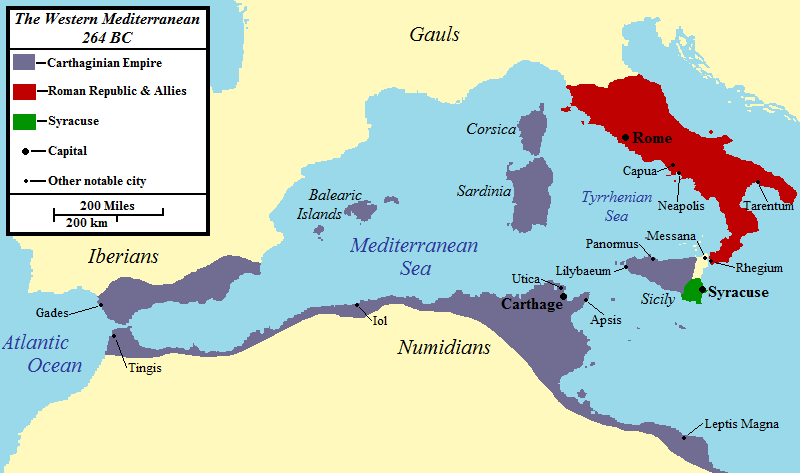
In the initial stages of the war, Carthage clearly had the advantage as the Carthage held the Navel supremacy in the Mediterranean at the time. yet soon after, Roman engineers studied Carthaginian Warships and were able to engineer assault war triremes of their own. In addition, Romans added another technological advancement to their ships as well. They invented “Corvus”, a type of an assault bridge that enables infantry soldiers to move from their ship to an enemy ship quickly and safely. Roman Legionaries quickly proved to be as deadly as in the sea as they are fatal on the ground.
The Roman Navy grew in numbers swiftly and was influenced by Egyptian assault ships as well. Soon, the Carthaginian Navy was no longer the superpower of the Mediterranean. Eventually, Rome would drive Carthage out of Sicily, Sardinia, and Corsica completely, emerging as the new Power of the Mediterranean.
The Battle of Zama (202BC) – the end of the Second Punic War by defeating Hannibal
After the humiliating defeat at the battle of Cannae at the hands of Hannibal, Scipio Africanus, one of the few survivors of Cannae, came back to North Africa to the gates of Carthage to settle the scores with Hannibal.
Rome had superior cavalry this time, especially due to the Masinissa Auxilary Cavalry support but still, the Carthage held the Infantry numerical superiority. In addition, Carthage was supported by 80 African War Elephants.
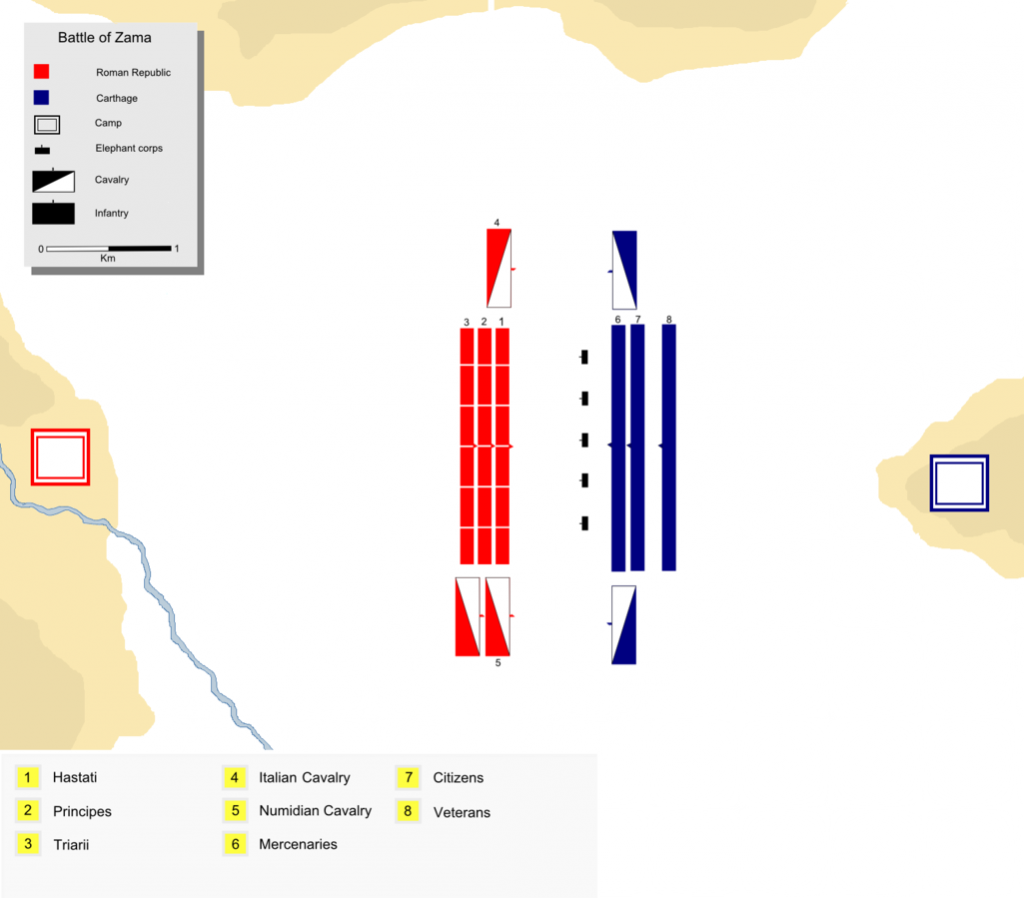
Roman Cavalry had the advantage against the Carthaginian Cavalry and quickly drew them off the battle. Scippio used loud trumpets to scare off the war elephants, who startled and attacked their own Carthaginian lines.
However, the battle between the two infantry lines was a stalemate. And for some time, no party gained a significant advancement in the field, until the victorious Roman cavalry charge the Carthaginian infantry line from the rear. This shattered the Carthaginian Ranks and eventually, Hannibal was forced to surrender.
The Battle of Alesia (52BC) – Julius Caesar’s conquest of Gaul
Julius Caesar had been campaigning in Gaul for nearly 6 years when the Vercingetorix, a brilliant chieftain threatened to undo all of that he accomplished. Vercingetorix defeated Caesar and his legions on several occasions. Finally, Caesar managed to trap the Gallic chieftain at Alesia but soon found himself and the legions surrounded by the Gallic reinforcements.
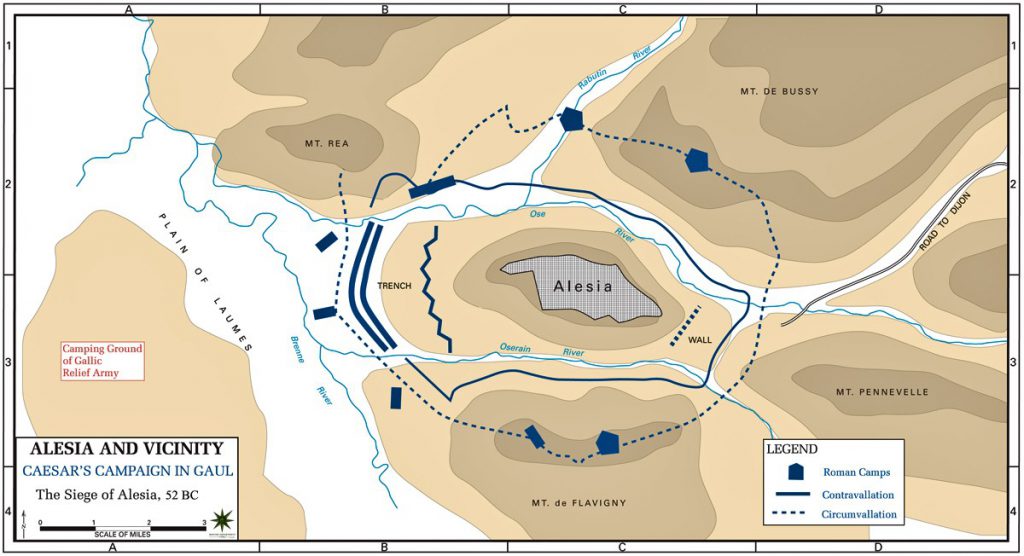
As Vercingetorix and his army had more men, Caesar decided to lay siege to the Settlement and ordered a 16-kilometer-long fortified wall to encircle Alessia with fortified towers to prevent attacks from Gauls and to force them to surrender. Caesar already knew that Vercingetorix had requested reinforcements from other Gallic tribes and prepared for that attack by constructing another outer wall around Roman troops with the same specifications as the inner wall which was constructed around Alesia. The Besieges were preparing to be Besieged!
Did you know?
The French Cartoon series, “ASTERIX and OBELIX” was inspired by the Gallic independence war and Vercingetorix’s victories over Roman Empire!
Caesar’s strategy proved a success! And soon the Gallic forces in Alesia were starving and Gallic reinforcement could not penetrate the outer wall built by Roman war engineers. Soon, Roman reinforcements arrived to aid the Caesar and repelled the Gallic armies. Vercingetorix was forced to Surrender and the era of Gallic independence ended with this surrender.
How many years did the Roman Empire last?
When did the Roman Empire start and end? A frequent questioned asked by many as there were three stages of governance in Rome’s history.
- Kingdom of Rome (753 BC to 509 BC)
- Roman Republic (509 BC to 27 BC)
- Roman Empire (27 BC – 476 AD) – The Roman Empire lasted for 503 years. After the fall of the Western Roman Empire, her Eastern Counterpart, the Byzantine Empire would survive until 1453 AD, for another millennium!
Did you know?
After the fall of the Western Roman Empire, her Eastern Counterpart, the Byzantine Empire would survive until 1453 AD, for other millennia or 1000 years!
Roman Empire Timeline 510 BC – 1453 AD
This video is created by EarthDirect
What brought down the Roman Empire?
Roman Empire experienced an unprecedented era of Peace and Prosperity from the reign of Augustus Caesar 27 BC and end after the death of Emperor Marcus Aurelius in 180 AD. This period was termed “Pax Romana” or the “Roman Peace”.
However, as the political division ran deep and power struggles emerged from the old ashes, the empire slowly yet inevitably plunged into chaos, which is called “The Crisis of the 3rd Century” where Roman Empire was hit by the combined pressure of invasions, civil strife, economic disorder, and famine.
What are the 4 major reasons for the fall of Rome?
1. Travel time from ancient Rome
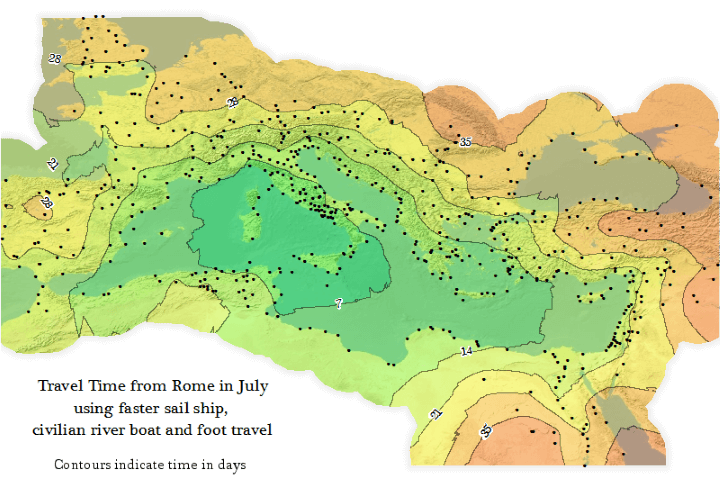
As the empire stretched from North Atlantic to the Middle East, during the time of peace it was easy for anyone to travel from one end to the other end of the empire. As foreign raids intensified and internal security collapsed, traveling within the empire became extremely dangerous and this had a deeply negative impact on trade, commerce, and economy.
2. The split of the Roman Empire
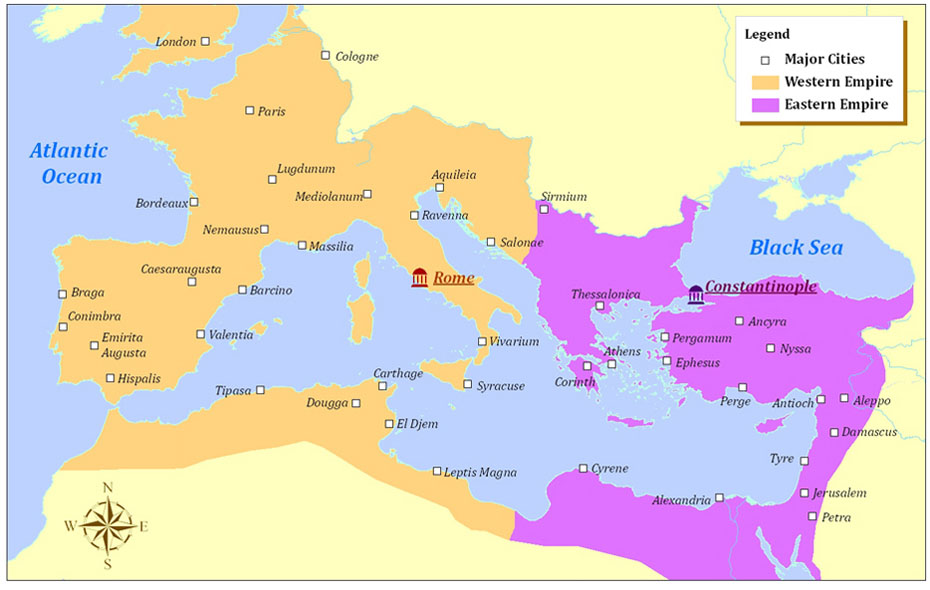
As Rome was too massive to be ruled by one ruler, it was divided into the Eastern part and the Western part. Eastern Empire was economically thriving, as the main trade route in Constantinople and the silk route laid through the East. Yet, the Western part was constantly under threat from Barbaric tribes and over-population along with economic decline.
3. Fast Christianity spread throughout the Roman Empire
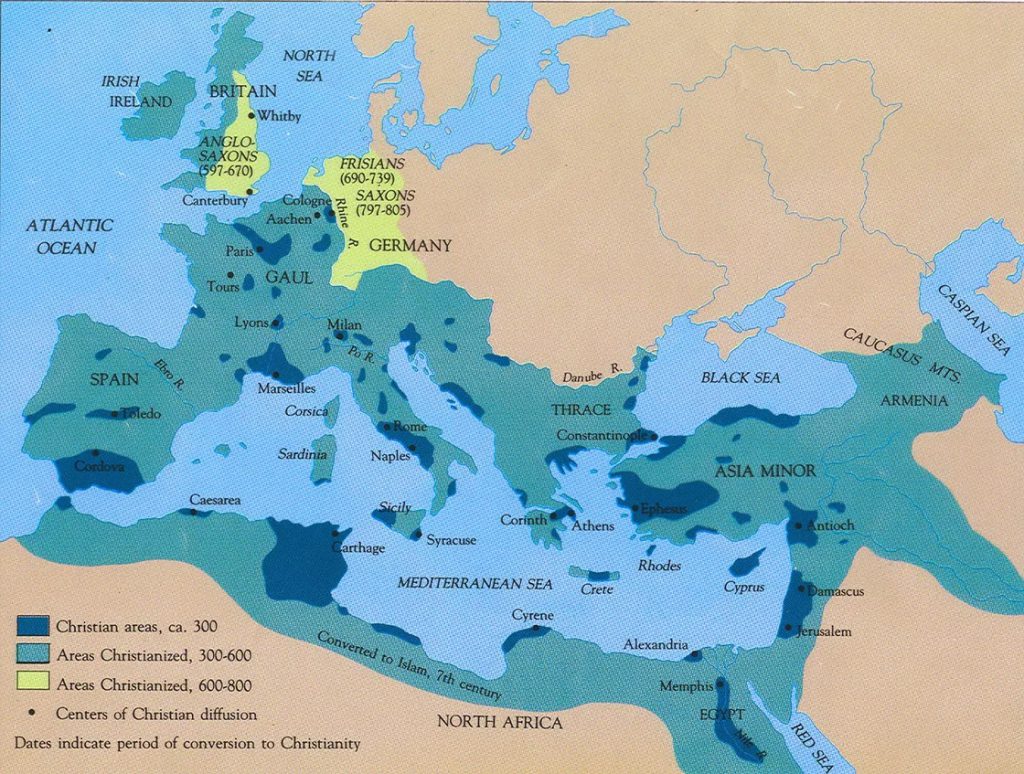
The religious wars between the ancient Roman religion, Paganism and Christianity intensified during this period and this conflict even spread to the Political arena. This destabilized the entire Social and Cultural Foundation of Roman Society.
4. Constant wars and military spending
As the economy went in to decline and foreign invasions grew rapidly, the military upkeep costs of the Western Empire escalated, yet the Imperial Treasury was nearly insolvent or Bankrupted. The Emperor or the Senate was no longer able to Afford legions. The Western Roman Empire’s dominion was at an end.
The fall of the Roman Empire
Barbarian Invasions (370-450 AD)
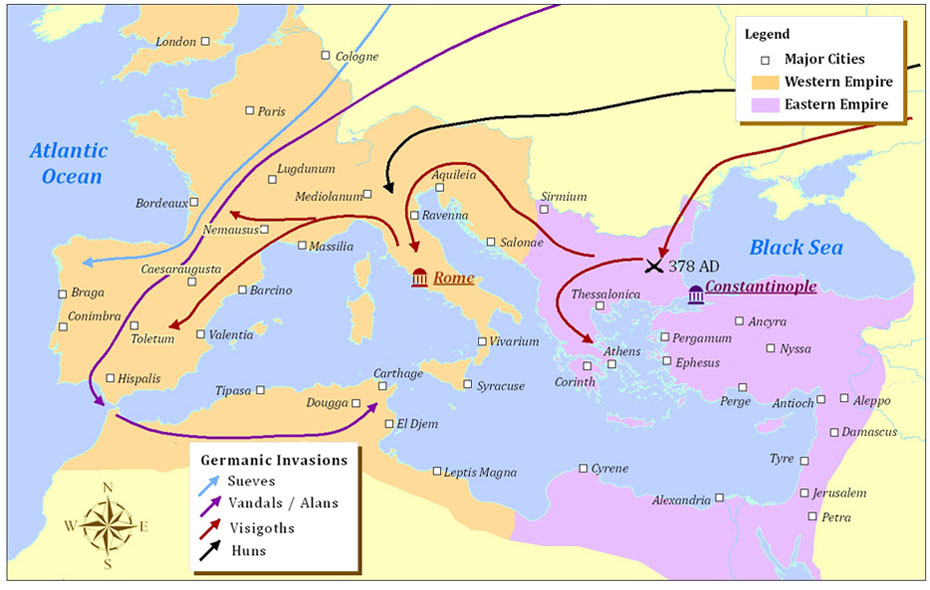
The Huns from the west, Germanic Tribes, Visigoths and Ostrogoths from the North and Vandals from South, along with Franks from Gaul continuously invaded the Roman territory and attacked Roman garrisons. They would go down the history as those Who defeated the Roman Empire.
Soon after, Rome found her armies stripped of Man-power required to protect her borders and citizens.
Barbarian Invasions (450-500 AD)
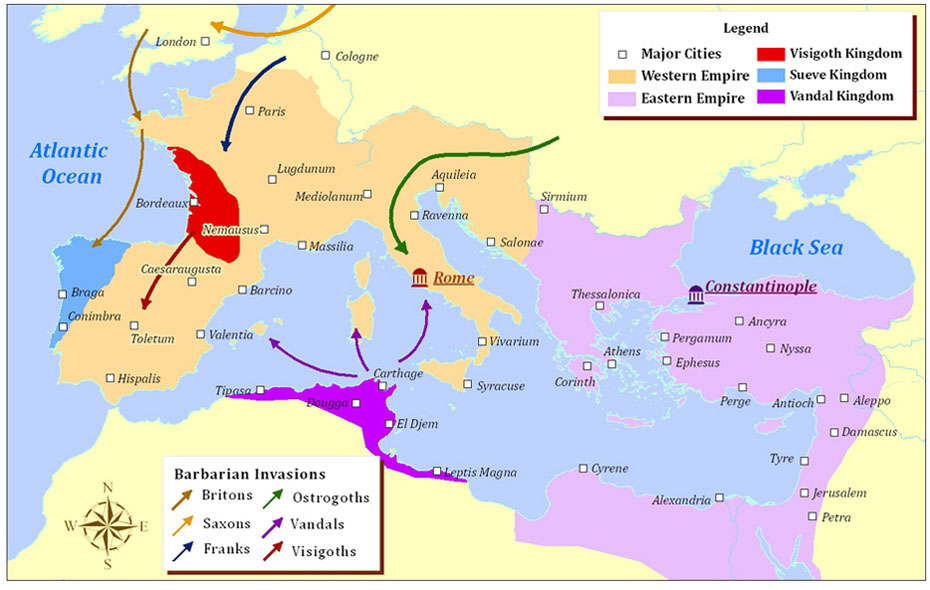
Germanic Kingdoms (500 AD)
Germanic tribes, especially Huns and Goths were getting more and more powerful and plundered the Empires Border cities and villages constantly, destroying garrisons and cities.
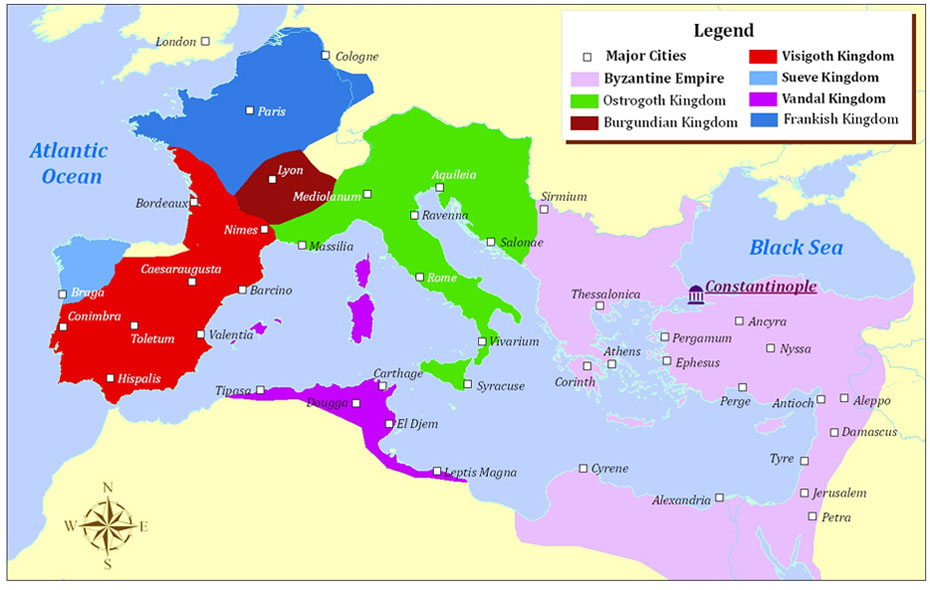
The exact answer to the question when did the Roman Empire fall is difficult to give. However, symbolically it could be the year 476 AD when the Imperial Insignia was sent to Constantinople.
3 major Roman military defeats inflicted by Hannibal
Hannibal was a strategic genius and inflicted 3 massive defeats on the Romans. Hannibal’s route of invasion started in Cartagena and its army marched through the Alps towards Rome to never actually attack the capital.
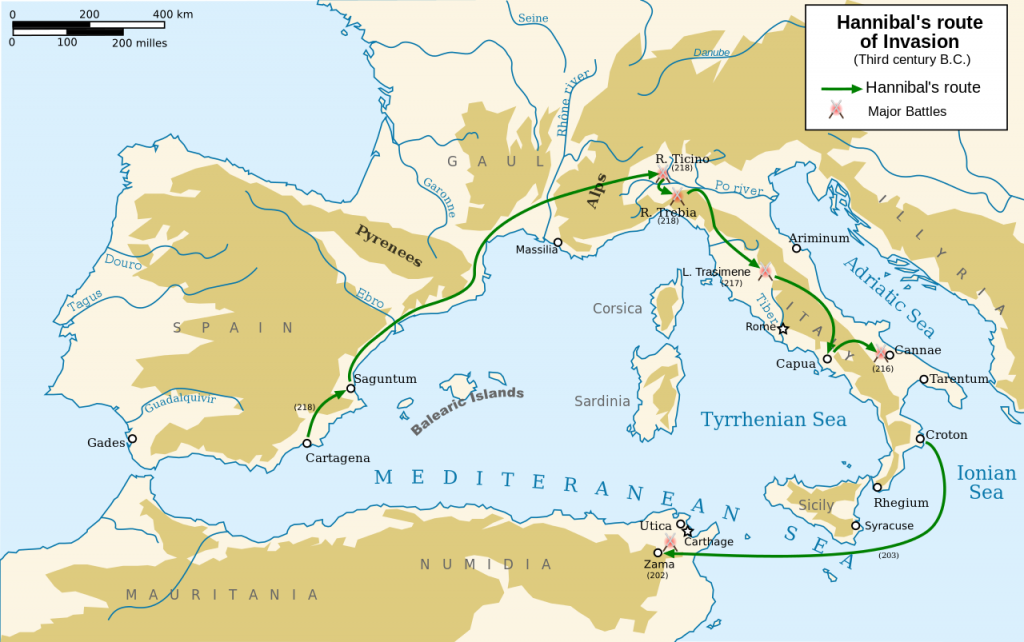
“I will either find a way… or Make One!”
Hannibal to Commander Maharbal before the Battle of Cannae.
Map of the 3 massive defeats of the Romans
This map shows where the 3 massive defeats inflicted by Hannibal’s army on the Roman Empire took place.
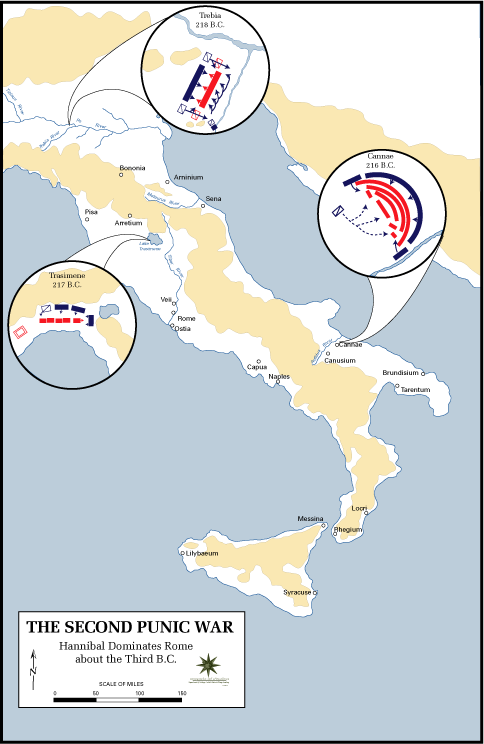
The battle of Trebia, 218 B.C., second Punic War, between Carthaginians and Romans
The battle began as a result of Hannibal trying to cross the Gaul to reach Italy. Romans tried to intercept but was forced to retreat under the attacks of the heavy Carthaginian cavalry.
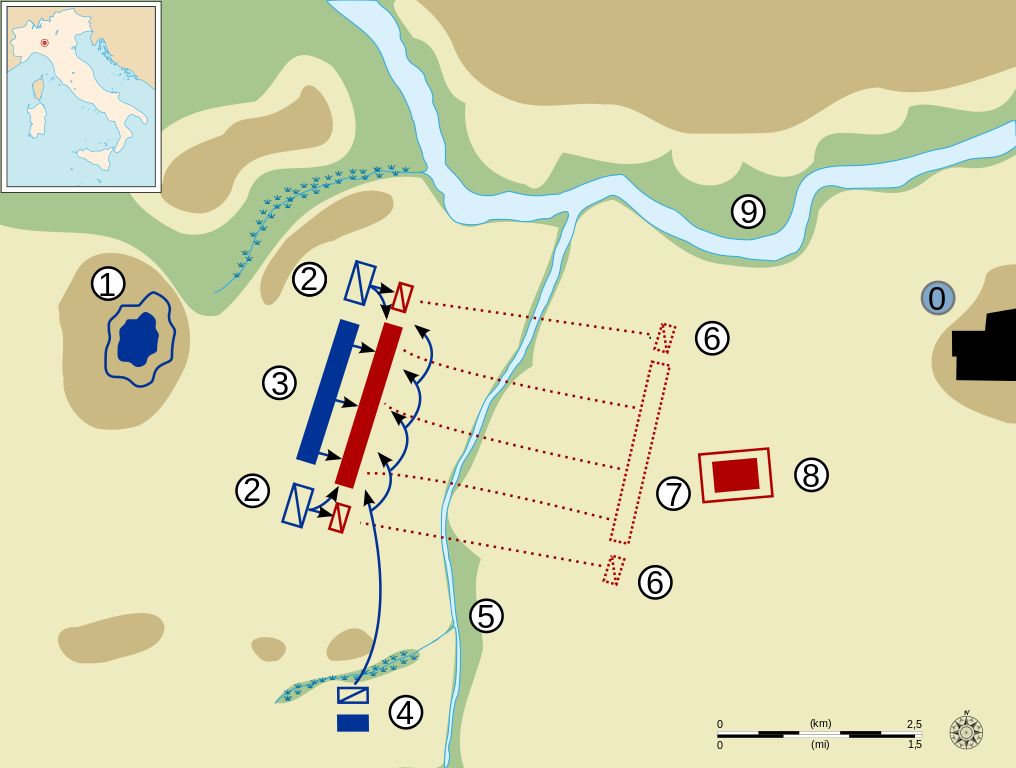
However, after some time, Romans camped near the Trebia River near Placentia and Hannibal came to face them. However, Roman infantry was much superior to Carthaginian forces so Hannibal tactfully made them weary and finally engaged the fatigue-stricken Legions with a surprise flank attack and an ambush.
- 1 Carthaginian camp
- 2 Carthaginian cavalry
- 3 Carthaginian infantry
- 4 Mago Barca’s detachment
- 5 Trebia river
- 6 Roman cavalry
- 7 Roman infantry
- 8 Roman camp
- 9 Po river
- 0 City of Placentia
“Hannibal, you know how to gain a victory, but not how to use one.”
Commander Maharbal
The Battle of Lake Trasimene (217 BC) – Hannibal’s Ambuscade
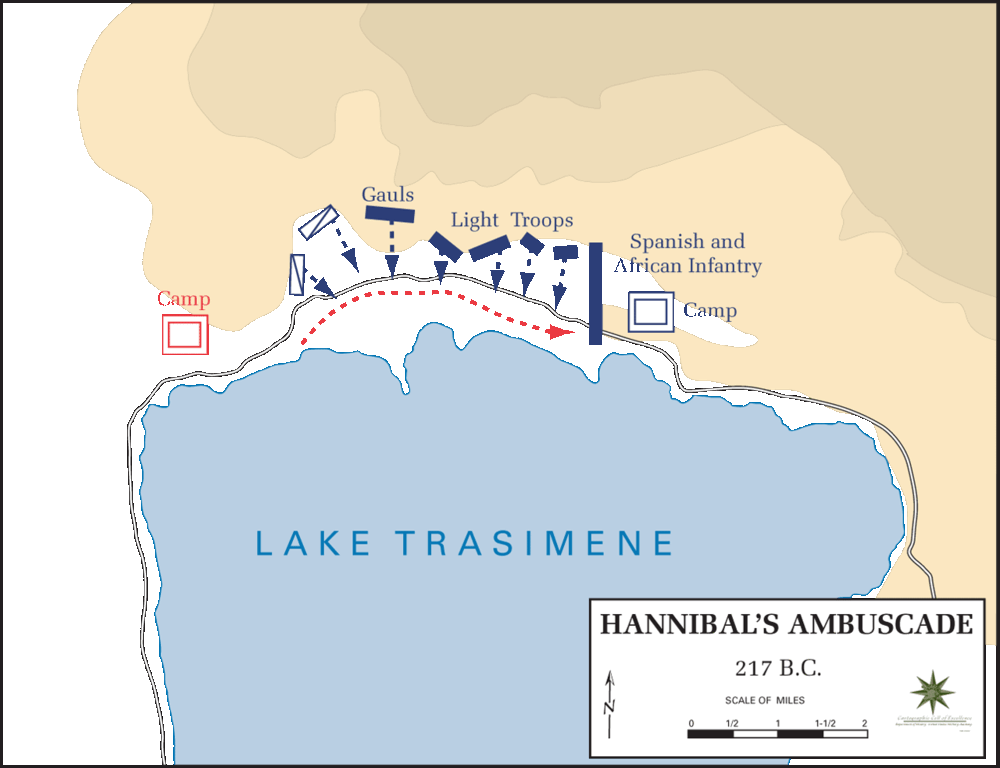
The Battle of Lake Trasimene is the costliest ambush the Roman army faced at the time. Hannibal provoked the Roman army into a hasty and a weary-some pursuit of his forces along the shore of the Lake Trasimene. Soon after, he led the Carthaginian army through the uplands near the shore, turned his army completely and ambushed Romans in a defile on the shore of the lake. The Roman army was inflicted heavy loses and even the commanding Consul of the Roman army was killed.
Did you know?
At the battle of the Cannae, Rome lost nearly One Fifth of their young male population between 18-35 years of age!
The battle of Cannae (215B.C.) – Destruction of the Roman Army
As Hannibal did the seemingly impossible, crossed the Alps and was skirmishing and defeating every army Rome sent at him, finally, the senate decided to send an army of 100,000 men to destroy Hannibal one and for all.
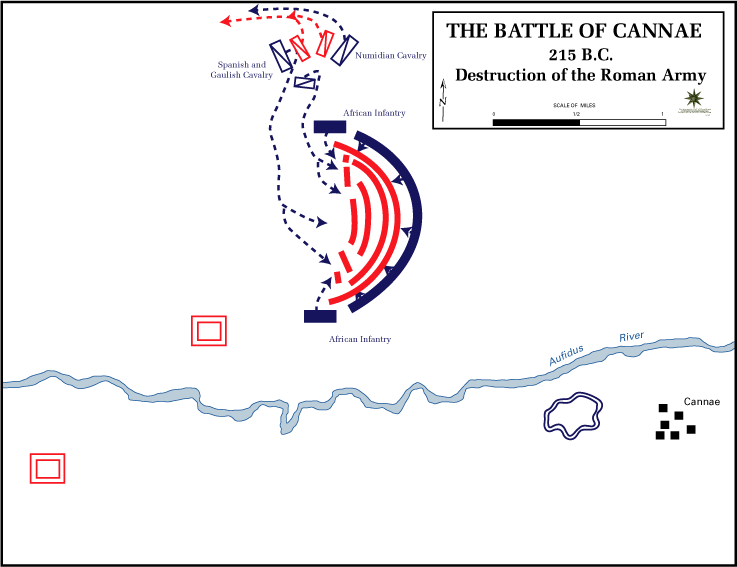
Hannibal was greatly out-numbered. With only 38,000 men and 8,000 cavalries. As a head-on battle would guarantee a Roman victory, Hannibal saw Roman Brute force could be overwhelmed by the strategic genius and employed an Envelop tactic, by making the center of the Carthaginian line weak and strengthening the flanks with elite forces.
The Romans forced their way through the weak Carthaginian Center, and eventually fell to the trap and was enveloped or surrounded. their numerical superiority meant nothing anymore as the combat area shrank and they were under attack from the flanks.
Did you know?
The carnage at Cannae is one of the Bloodiest Battles in the Human History in terms of highest number of deaths in a Single day.
Finally, the Carthaginian cavalry, having defeated Roman Cavalry, charged the Romans from the Rear. Thus, surrounding the Legions altogether. More than 70,000 Romans were killed or captured that day and Rome never went on to a pitched-battle again.
Roman Emperors Timeline
- Augustus, (Octavian) first emperor, grandnephew of Julius Caesar, (27 B.C.–A.D. 14)
- Tiberius, stepson of Augustus, (14–37)
- Caligula, grandnephew of Tiberius (37–41)
- Claudius, uncle of Caligula (41–54)
- Nero, stepson of Claudius (54–68)
- Galba, proclaimed emperor by his soldiers (68–69)
- Otho, military commander (69)
- Vitellius, military commander (69)
- Vespasian, military commander (69–79)
- Titus, son of Vespasian (79–81)
- Domitian, son of Vespasian (81–96)
- Nerva, elected interim ruler (96-98)
- Trajan, adopted son of Nerva (98–117)
- Hadrian, ward of Trajan (117–138)
- Antoninus Pius, adopted by Hadrian (138–161)
- Marcus Aurelius, adopted by Antoninus Pius (161–180)
- Lucius Verus, adopted by Antoninus Pius; ruled jointly with Marcus Aurelius (161–169)
- Commodus, son of Marcus Aurelius (180–192)
- Pertinax, proclaimed emperor by the Praetorian Guard (193)
- Didius Julianus, bought office from the Praetorian Guard (193)
- Severus, proclaimed emperor (193–211)
- Caracalla, son of Severus (211–217)
- Geta, son of Severus, ruled jointly with Caracalla (211–212)
- Macrinus, proclaimed emperor by his soldiers (217–18)
- Heliogabalus, cousin of Caracalla (218–222)
- Alexander Severus, cousin of Heliogabalus (222–235)
- Maximin, proclaimed emperor by soldiers, (235–238)
- Gordian I, made emperor by the senate (238)
- Gordian II, son of Gordian I, ruled jointly with his father (238)
- Balbinus, elected joint emperor by the senate (238)
- Pupienus Maximus, elected joint emperor with Balbinus by the senate (238)
- Gordian III, son of Gordian II (238–244)
- Philip (the Arabian), the assassin of Gordian III (244–249)
- Decius, proclaimed emperor by the soldiers (249–2251)
- Hostilianus, son of Decius, colleague of Gallus (251)
- Gallus, military commander (251–253)
- Aemilianus, military commander (253)
- Valerian, military commander (253–260)
- Gallienus, son of Valerian, co-emperor with his father and later sole emperor (253–268)
- Claudius II, military commander (268–270)
- Aurelian, chosen by Claudius II as successor (270–275)
- Tacitus, chosen by the senate (275–276)
- Florianus, half brother of Tacitus (276)
- Probus, military commander (276–282)
- Carus, proclaimed by the Praetorian Guard (282–283)
- Carinus, son of Carus (283–285)
- Numerianus, son of Carus, joint emperor with Carinus (283–284)
- Diocletian, military commander, divided the empire; ruled jointly with Maximian and Constantius I 284–305)
- Maximian, appointed joint emperor by Diocletian (286–305)
- Constantius I, joint emperor and successor of Diocletian (305–306)
- Galerius, joint emperor with Constantius I (305–310)
- Maximin, nephew of Galerius (308–313)
- Licinius, appointed emperor in the West by Galerius; later emperor in the East (308–324)
- Maxentius, son of Maximian (306–312)
- Constantine I (the Great), son of Constantius I (306–337)
- Constantine II, son of Constantine I (337–340)
- Constans, son of Constantine I (337–350)
- Constantius II, son of Constantine I (337–361)
- Magnentius, usurped Constans’ throne, (350–353)
- Julian (the Apostate), nephew of Constantine I (361–363)
- Jovian, elected by the army (363–364)
- Valentinian I, proclaimed by the army; ruled in the West (364–375)
- Valens, brother of Valentinian I; ruled in the East (364–378)
- Gratian, son of Valentinian I; co-ruler in the West with Valentinian II (375–383)
- Maximus, usurper in the West (383–388)
- Valentinian II, son of Valentinian I, ruler of the West (375–392)
- Eugenius, usurper in the West (393–394)
- Theodosius I (the Great), appointed ruler of the East (379–395) by Gratian; last ruler of the united empire (394–395)

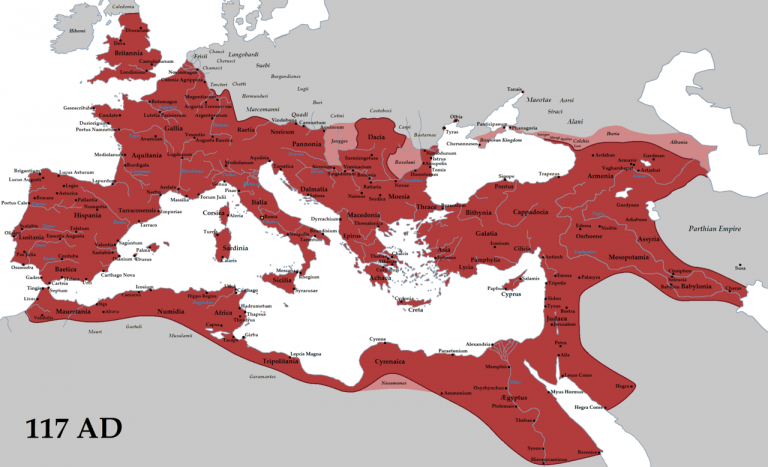
0 Comments